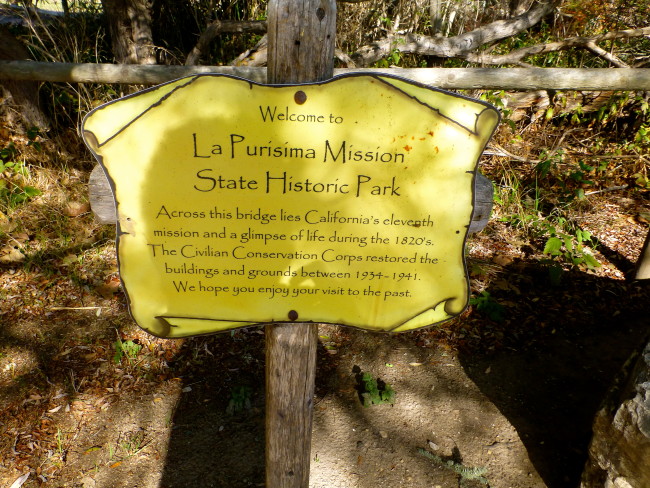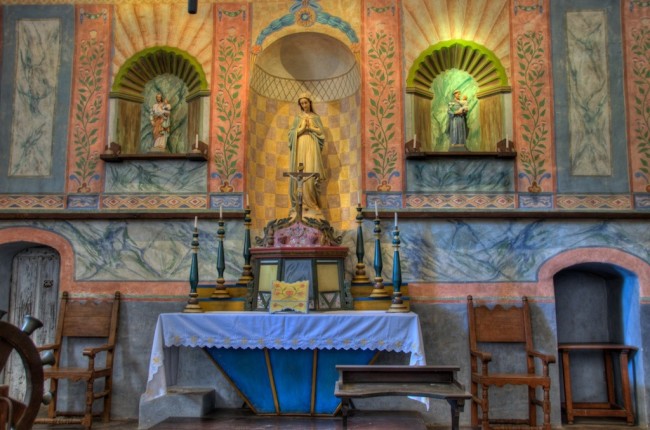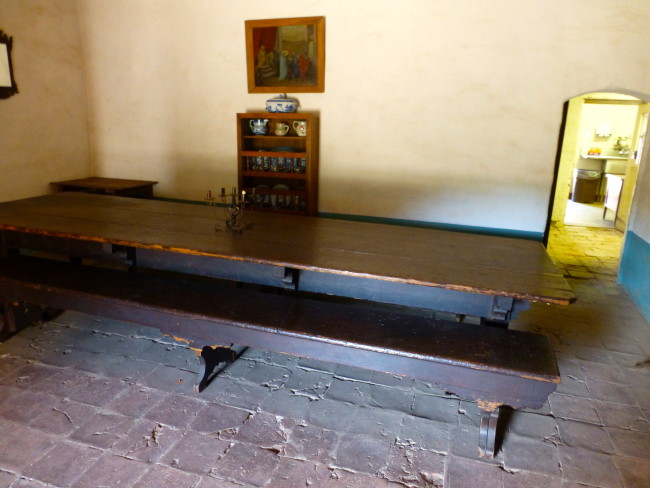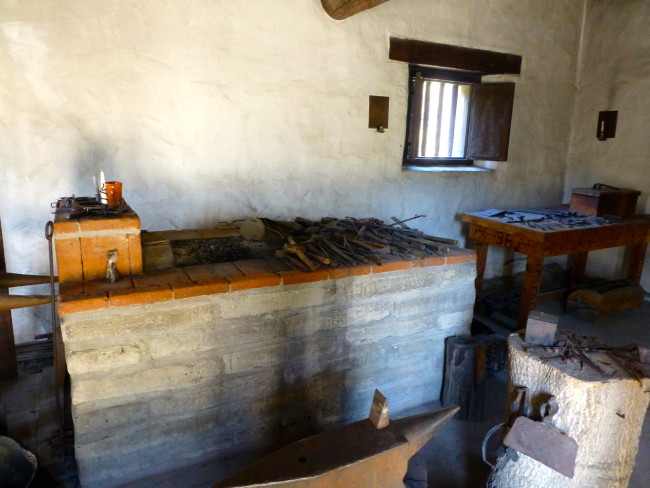
Old Mission Santa Barbara
April 12, 2014
Misión San Francisco de Asís
April 13, 2015A Little Off The Beaten Path
 La Purisima Concepción/La Purisima Mission State Historic Park
La Purisima Concepción/La Purisima Mission State Historic Park
I had taken a break from my goal to reach all 21 missions, so it was back on the trail in late November for me in my mission quest to visit all 21. In reality, La Purisima Concepción was the 11th of the 21 Alta California missions to be founded; however for us it became #12 on our ultimate Mission mission.
 For some reason, I had a preconceived notion that there wouldn’t be much to see at La Purisima (located between Solvang and Lompoc), which only proves that preconceived notions are often incorrect. Tracy and I (along with friends Greg and Gloria) decided to take the self-guided tour of the La Purisima Mission State Historic Park, and it turned out to be a surprising visit.
For some reason, I had a preconceived notion that there wouldn’t be much to see at La Purisima (located between Solvang and Lompoc), which only proves that preconceived notions are often incorrect. Tracy and I (along with friends Greg and Gloria) decided to take the self-guided tour of the La Purisima Mission State Historic Park, and it turned out to be a surprising visit.
 We arrived early on a Saturday morning and, after gazing up to the Landmark Cross and seeing that the nearby visitor center was closed, walked from the parking lot across the footbridge back into a little bit of California history.
We arrived early on a Saturday morning and, after gazing up to the Landmark Cross and seeing that the nearby visitor center was closed, walked from the parking lot across the footbridge back into a little bit of California history.
This location was actually the second site for this mission (the first one was destroyed by “earthquakes and torrential rains”) in 1812. By rebuilding at this location, La Purisima was now situated very near (a little more than one mile) the El Camino Royal (Royal Highway).
 We almost immediately realized that this is a “working mission,” when we stopped by to say “hello” to an animal with some sharp looking horns. He immediately devoured Tracy’s hand.
We almost immediately realized that this is a “working mission,” when we stopped by to say “hello” to an animal with some sharp looking horns. He immediately devoured Tracy’s hand.
 Not really. As you can see Tracy and Gloria, posing with the not-so-ferocious or camera-shy beast, were never really in fear of their lives. I, on the other hand, kept my distance.
Not really. As you can see Tracy and Gloria, posing with the not-so-ferocious or camera-shy beast, were never really in fear of their lives. I, on the other hand, kept my distance.
 By 1820, La Purisima’s population had reached nearly 900 people, and according to a nearby sign, included “Franciscan padres, soldiers, skilled craftsman and Chumash Indians.”
By 1820, La Purisima’s population had reached nearly 900 people, and according to a nearby sign, included “Franciscan padres, soldiers, skilled craftsman and Chumash Indians.”
 The next stop was a place where you could literally hide.
The next stop was a place where you could literally hide.
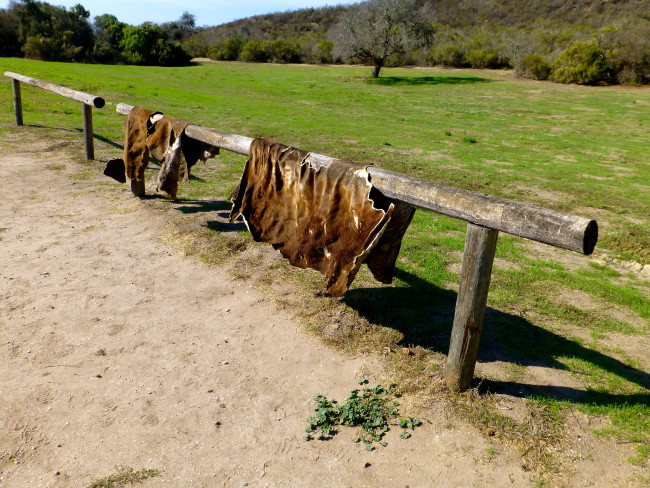 The Hide Racks Los Tenedederos de Cuero is where the cowhides were cleaned and dried and then traded with Yankee ships (no A-Rod however) in exchange for manufactured goods and even dishes.
The Hide Racks Los Tenedederos de Cuero is where the cowhides were cleaned and dried and then traded with Yankee ships (no A-Rod however) in exchange for manufactured goods and even dishes.
 The four of us walked toward the cemetery, which seemed appropriate since we had partaken in a little too much wine tasting the previous day in the Santa Ynez Valley and were all feeling rather dead.
The four of us walked toward the cemetery, which seemed appropriate since we had partaken in a little too much wine tasting the previous day in the Santa Ynez Valley and were all feeling rather dead.
Looking up, we viewed the mission bells. The bells were cast in Lima, Peru, which I found out were called the “City Of Bells,” because so many bell foundries were located there. La Purisima’s bells would call the inhabitants to mass, meals or work.
 The Cemetery El Camposanto has just one lonely cross, representing all the people that are buried on these grounds…and it’s a substantial number. Supposedly, there are hundreds of Chumash Indians and Spaniards buried here.
The Cemetery El Camposanto has just one lonely cross, representing all the people that are buried on these grounds…and it’s a substantial number. Supposedly, there are hundreds of Chumash Indians and Spaniards buried here.
Next stop was the Waste Drain, which did exactly what you think it did. You only get the straight poop on Travels With MaiTaiTom.
 The Tallow vats (which are a reproduction of the originals) were nearby. This is where “large chunks of beef fat were melted and purified, and the rendered tallow was stored in cowhide bags to be traded with foreign ships or used at the mission for cooking, making candles or soap.” I wondered how the food tasted, especially if they mixed in a little soap.
The Tallow vats (which are a reproduction of the originals) were nearby. This is where “large chunks of beef fat were melted and purified, and the rendered tallow was stored in cowhide bags to be traded with foreign ships or used at the mission for cooking, making candles or soap.” I wondered how the food tasted, especially if they mixed in a little soap.
 We came upon buildings that included the Pottery Shop,where thousands of roof and floor tiles were made…
We came upon buildings that included the Pottery Shop,where thousands of roof and floor tiles were made…
…and then over to the Granary. These gristmills were actually powered by burros for grinding wheat, corn and barley into meals for those who lived here.
 We stopped by the Community Kitchen where the Native American women would prepare the meals for some of the inhabitants, the padres and their guests…
We stopped by the Community Kitchen where the Native American women would prepare the meals for some of the inhabitants, the padres and their guests…
 …and walked the grounds for a bit…
…and walked the grounds for a bit…
…before heading inside the Padres Chapel, where I assume they pray for a San Diego World Series winner each year.
I stopped briefly to confess that I, too, was a fan.
 We were unable to get into the church (or just tried the wrong door…that wine tasting can take its toll on your brain function), however below are a couple of nice photos from the official mission website that probably are better than any I would have taken. I’ll have to return, because the photos look lovely.
We were unable to get into the church (or just tried the wrong door…that wine tasting can take its toll on your brain function), however below are a couple of nice photos from the official mission website that probably are better than any I would have taken. I’ll have to return, because the photos look lovely.
We took a look at one of the old Purisima Bells (from 1818) on display, and then we wandered over to the Taller de Pielles (Leather Shop).
Next stop on this seemingless endless self-guided tour was the Cuarto del Padre (Priest’s Room)…
 …and we booked it over to the Priest’s Library and Office.
…and we booked it over to the Priest’s Library and Office.
It was now time to hit the trail (literally), and we visited some pigs that were having a grand old time on a hot morning rolling around in the mud.
I wouldn’t say they were going hog wild, but they did seem to be hamming it up a little for us.
 The vegetable garden seemed to be devoid of vegetables, and we couldn’t find the Spring House (maybe because we visited in late Autumn).
The vegetable garden seemed to be devoid of vegetables, and we couldn’t find the Spring House (maybe because we visited in late Autumn).
 Although not located under a spreading chestnut tree, we stopped by La Herreria (the Blacksmith Shop), where the village smithy stood. The sign denotes it was “an integral part of the Mission.” Hopefully, the blacksmith forged a good future for many.
Although not located under a spreading chestnut tree, we stopped by La Herreria (the Blacksmith Shop), where the village smithy stood. The sign denotes it was “an integral part of the Mission.” Hopefully, the blacksmith forged a good future for many.
The Tule Village is where the Chumash Indians built homes from tule reed.
 Central air might have been needed on days like these.
Central air might have been needed on days like these.
There are a number of hikes that start from La Purisima Mission State Historic Park, and as Joyce Kilmer would say, “I think I will never see, a hike so lovely filled with trees.” Ok, maybe not.
There were some crosses in the garden area, however I was at a loss to explain the one on the right.
My Punxsutawney Phil sundial photo highlighted my shadow, which I believe meant six more hours of bad photographs.
 Had I known our next stop, I might have brought laundry…or my swim trunks…it was the “Indian Lavanderia.” The sign said, “Unlike Europeans, the Chumash Indians enjoyed bathing (that’s interesting). This lavanderia provided a clothes’ washing and bathing area for the residents of the Indian Apartments and Tule Village.” Alas, there was no water anyway.
Had I known our next stop, I might have brought laundry…or my swim trunks…it was the “Indian Lavanderia.” The sign said, “Unlike Europeans, the Chumash Indians enjoyed bathing (that’s interesting). This lavanderia provided a clothes’ washing and bathing area for the residents of the Indian Apartments and Tule Village.” Alas, there was no water anyway.
 There was water, however, at the nearby Fuente (Fountain).
There was water, however, at the nearby Fuente (Fountain).
And we found even more water at a newer fountain.
 We walked around the beautiful and peaceful grounds for another 15 or 20 minutes…
We walked around the beautiful and peaceful grounds for another 15 or 20 minutes…
…but the call of the nearby vineyards could be heard in the distance.
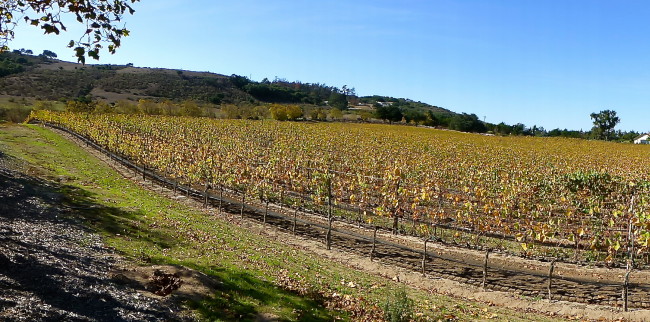 La Purisima Concepción is one of only two of the Spanish missions in California that is no longer under the control of the Catholic Church (Mission San Francisco de Solano is the other).
La Purisima Concepción is one of only two of the Spanish missions in California that is no longer under the control of the Catholic Church (Mission San Francisco de Solano is the other).
A little off the beaten path (but not much), La Purisima Concepción, a part of the La Purisima Mission State Historic Park, is a great little detour. Next time we’re in the area, I think we’ll stop by, take one of the 90-minute guide tours they offer, go on a couple of hikes and find out how to get in the church.
Facts:
La Purisima Concepción/La Purisima Mission State Historic Park
2295 Purisima Rd, Lompoc, CA 93436
Hours: Tuesday – Sunday 10 a.m. – 5 p.m. • Monday 11 a.m. – 3 p.m.
Admission: $6
Docent Guided Tours: Free (Daily at 1 p.m.)
Parking: Free
Telephone: 805.733.3713
www.lapurisimamission.org


